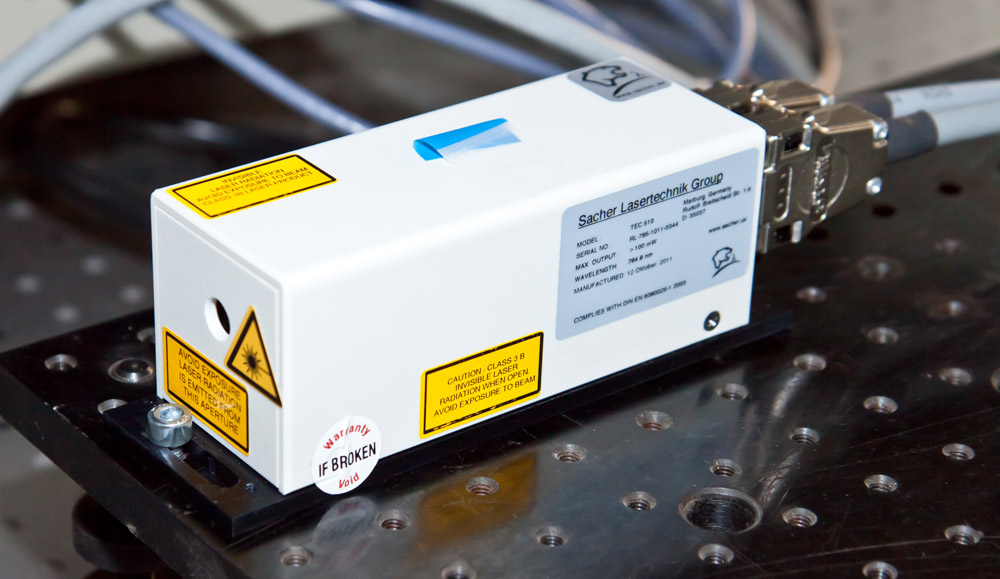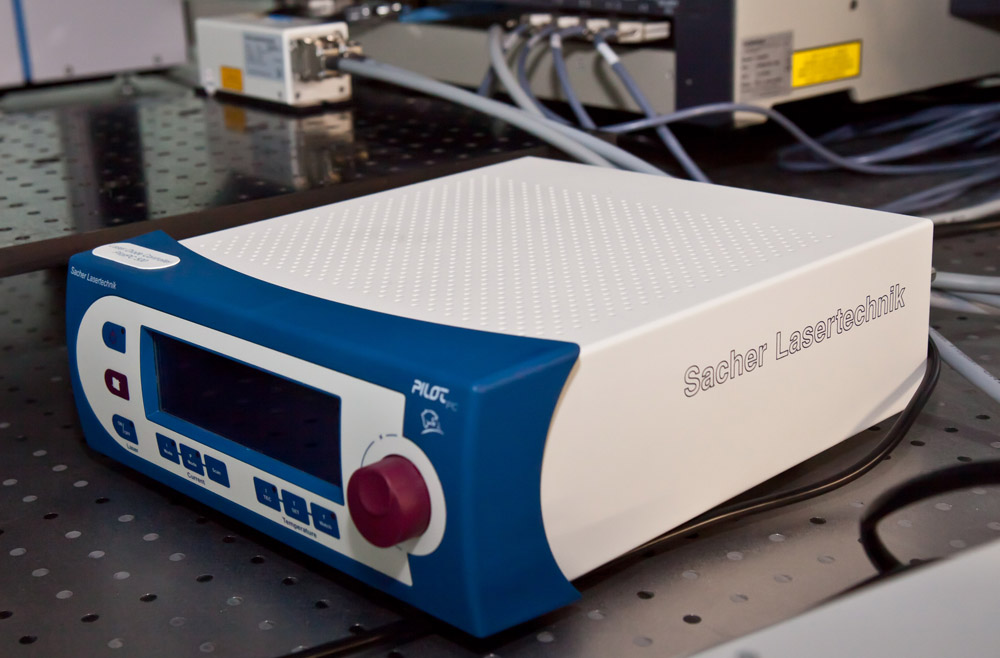Posted in Научное оборудование
1. Oscilloscope 4-channel 1 GHz DSO 9104A (Agilent Technologies)
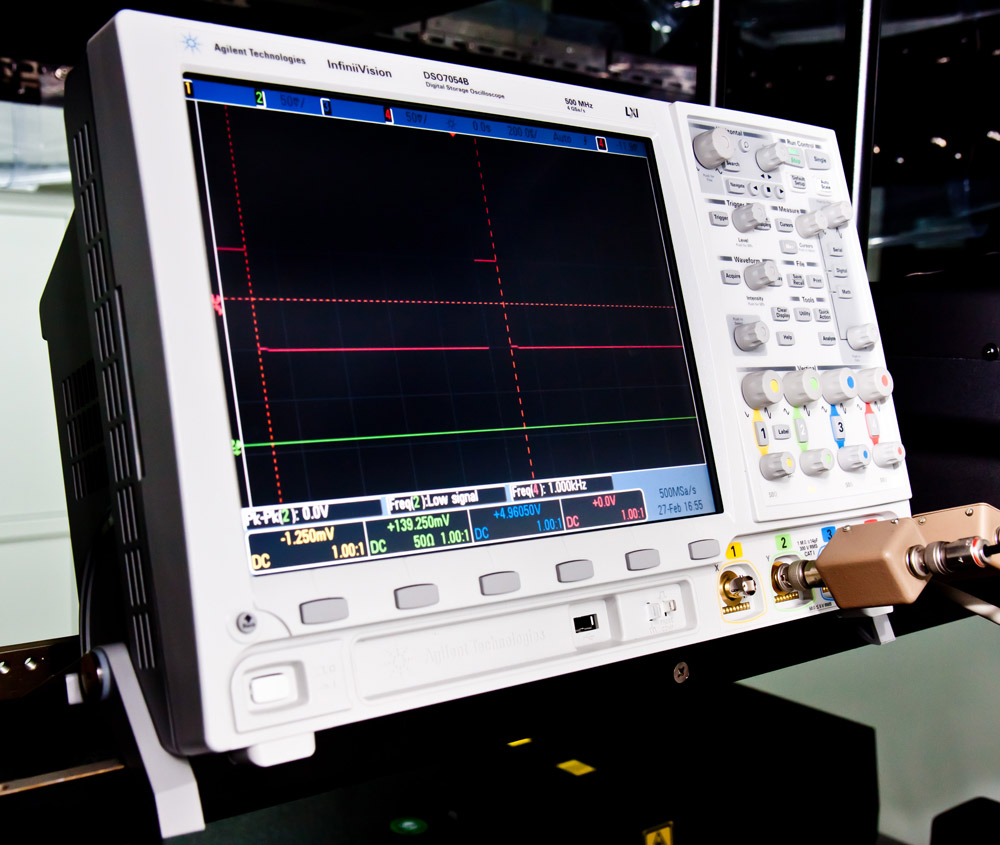
Main characteristics:
The analog signal bandwidth of 1 GHz.
Rise time of 300 ps.
Coefficient of isolation between channels 40 dB.
Bit 8-bit vertical.
Bit vertical (when averaged) 12-bit.
2. Thermovision camera Ti32 (Fluke)
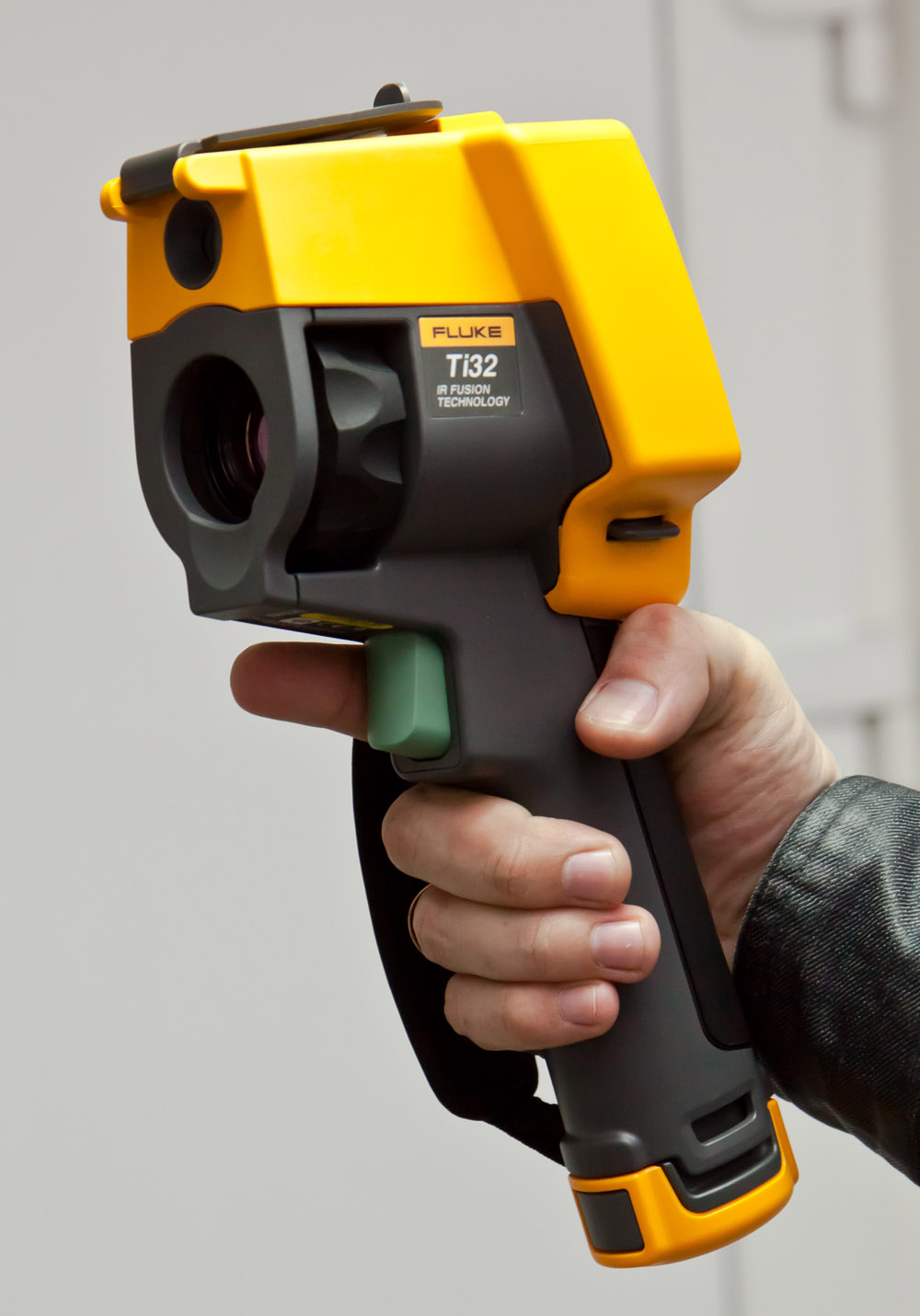
Main characteristics:
Measured temperature range from -20 to 600 °С.
Temperature accuracy - 2 °С
Sensitivity (at 30 °С) – 50 mK.
The field of view of the main – 23° x 17°
3. pH meter portable ANION 7000
Main characteristics:
measuring an electromotive force (EMF) and the redox potential (Eh):
in the range from - 1200 to +1200 mV;
with a resolution of 1 mV;
with an accuracy of 2 mV.
measuring the activity of hydrogen ions (pH)
from 0 to 14;
in increments of 0.01;
with an accuracy of 0.02.
measuring the activity of the ions of nitrogen trioxide (pNO3):
ranging from 1 to 6;
in increments of 0.01;
with an accuracy of 0,05.
measurement of the temperature of water environments:
ranging from 0 °C to 100 °C;
with a resolution of 0,1 °C;
with an accuracy of 0,3 °C.
system provided avtotermokompensatsii (ATC):
from 0 to 60 °C;
with an accuracy of 0.04 units.
4. Discovery Semi-Micro Analytical Balances DV-215CD (Ohaus)
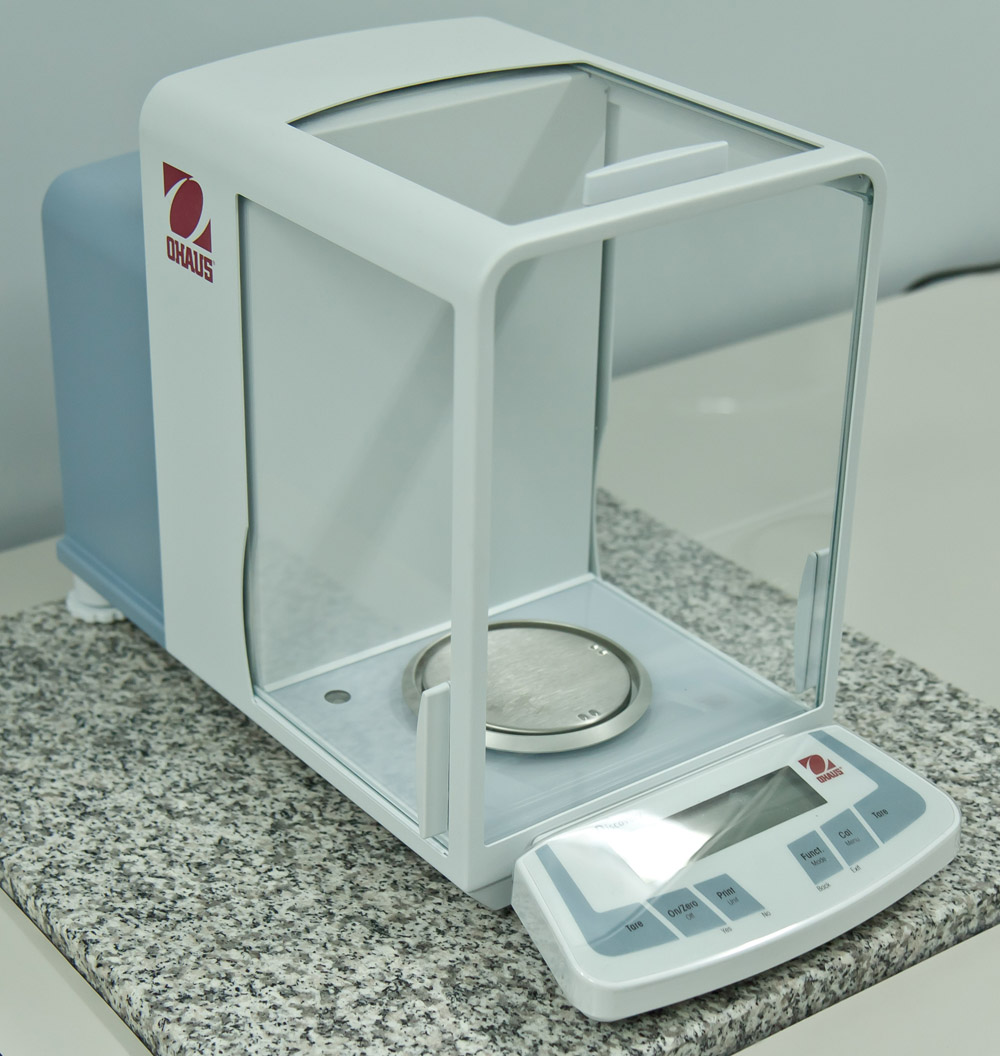
Main characteristics:
Weight cup of chemically resistant steel.
The possibility of determining the density of substances (hydrostatic weighing), the function of dynamic weighing.
Number 2 weighing ranges:
from 0 to 81 g, graduation 0.01 mg;
from 0 to 210 g, graduation 0.1 mg.
Accuracy class according to GOST 24104-1988: I.
Accuracy class according to GOST 24104-2001: I.
Integrated full self-calibration weights.
Information on the manufacturer's website
5. Laboratory centrifuge Sigma 2-16P (Sigma Laborzentrifugen)
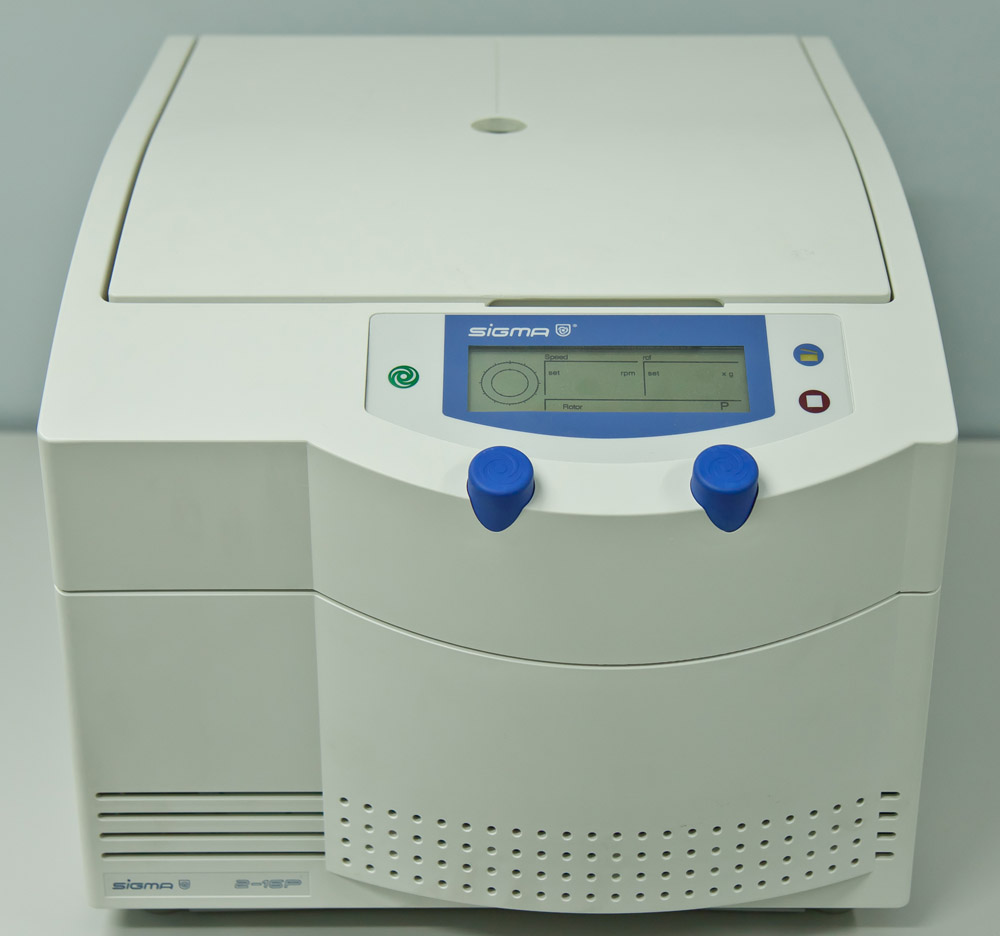
Main characteristics:
Maximum capacity in a swing-out rotors: 4 vials of 120 ml.
The maximum speed of 15 000 rpm. / Min.
Ability to work at a low speed of 100 rev. / Min.
The system of protection of rotor imbalance.
The noise level at maximum speed 67 dB.
6. Modular data acquisition system and the automation:
Main characteristics:
- 8-slot chassis for PXIe-1082 8-Slot 3U PXI Express Chassis - 2 pcs.;
- Chassis 5-slot NI PXIe-1073 Integrated MXIe, 5 Periph Slot, ExpressCard, 3m Cable - 3 piece.;
- Controller NI PXIe-ExpressCard8360, ExpressCard MXI for PXI Express, 3m Cable - 2 pcs.;
- Multimer NI PXI-4070 6 1/2 Digit FlexDMM (1.8 MS / s Digitzer, 300 V, 1 A) - 2 pcs.;
- Digital multimer NI PXI-4072 6 1/2 Digit FlexDMM and LCR Meter - 1 piece.;
- A module for thermocouple NI PXIe-4353 32-Channel, 24-bit, 80S / s Thermocouple Input Module, NI-DAQmx Driver, and LabVIEW SignalExpress LE - 2 pcs.;
- Interface USB D-sub NI USB-232/4 - 3 pc.;
- RS-232 PXI NI PXI-8430/4 - 3 pc.;
- Map data acquisition NI PXIE-6251 M SERIES MULTIFUNCTION DAQ DEVICE AND NI-DAQMX DRIVER SOFTWARE - 3 piece.;
- Power NI PXI-4022 - 2 piece.;
- Stepper Motor Controller NI PXI-7344 4-Axis Stepper / Servo Motion Controller - 2 pcs.;
- Stepper Motor Driver P70360 Stepper Drive, 120 or 240 VAC powered, 2.5 A continuous current, 1 axis - 2 pcs.;
- High-speed generator NI PXI-6733 - 1 pc.
7. Discotom-6 cut-off machine
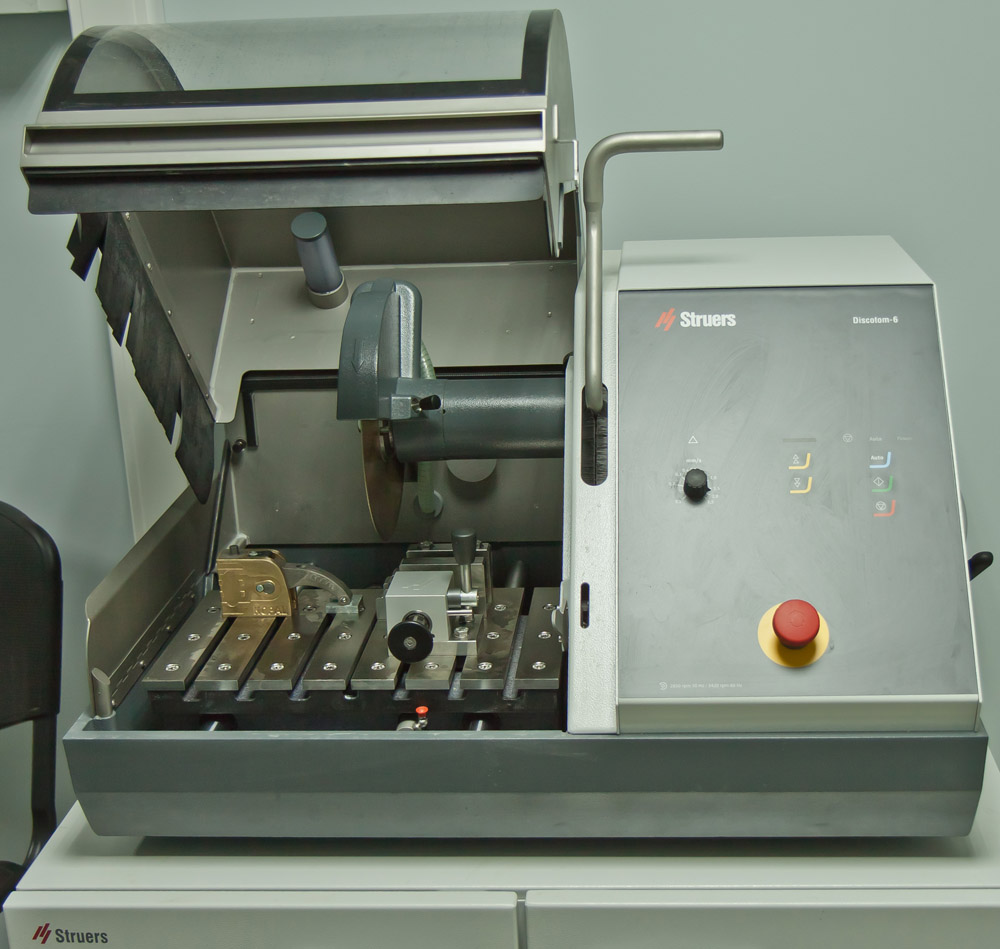
Discotom -6 is a high performance table-top cut-off machine with a strong 3.7 kW (5.0 HP) motor. . It is designed for cut-off wheels with a diameter of 250 mm (10"). Discotom-6 can be operated both automatically and manually, making it suitable for a wide range of applications.
Main characteristics:
- Ability to cut both manual and automatic modes.
- Electronic control of the feed rate.
- Ability to set cut-off wheels with a hole diameter of 32 mm (for use available in the laboratory cutting discs) and the outside diameter of 250 mm.
- Cut Capacity: samples with a diameter of 80 mm or sections up to 140mm x 65mm.
- Built-cutting table.
- The speed of rotation of the cutting disc - 2850 rev / min.
- Special flexible sidebar for cutting long workpieces, protruding from the cutting chamber.
- The system of coolant on the cutting blade during the cutting process.
- Device for installing and fixing the samples. The maximum width of the clamp 50 mm.
- Vertical clamping system. For clamping on the cutting table irregularly shaped parts up to 60 mm.
- Recirculation cooling system with a tank volume of 50 liters and the static filter block with replaceable filter paper.
Information on the manufacturer's website
8. Semi-automatic grinding and polishing machine Tegramin-25
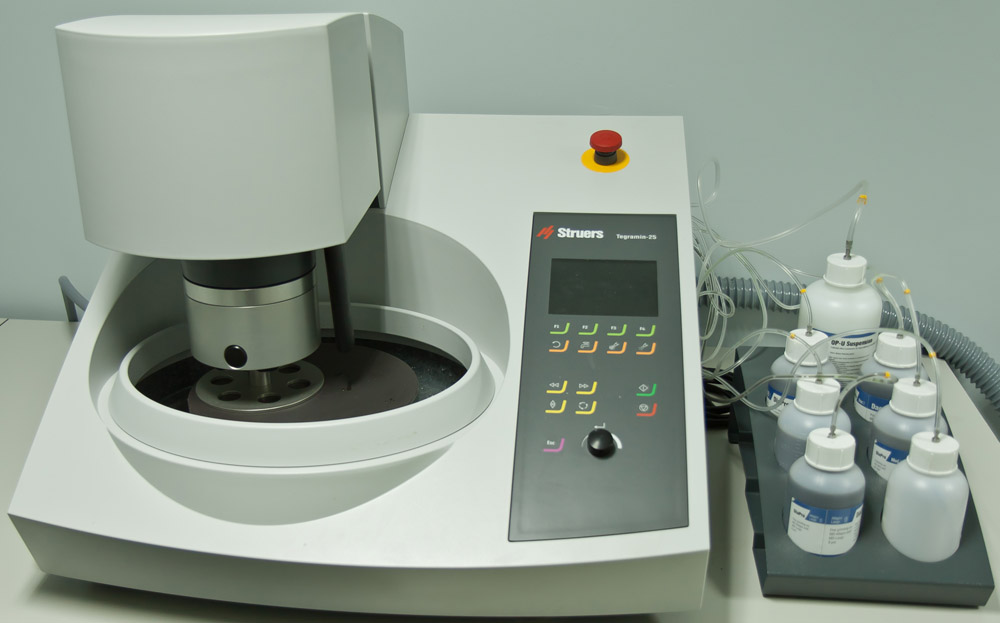
The Tegramin preparation system elegantly combines ease of use with advanced functionality. lnnovative solutions improve preparation results and help you deal with a variety of specimens or materials, or high specimen volume. Used for treatment (grinding and polishing) of solid samples for optical studies.
Main characteristics:
- Grinding and polishing disc diameter of 250 mm.
- Controllable drive speed range from 40 to 600 rev / min in increments of 10 rev / min.
- Possibility of manual and automatic processing of the sample.
- Speed grinding and polishing devices - from 50 to 150 rev / min in steps of 10 rev / min, given by the direction of rotation clockwise and counter-clockwise.
- Ability to process individual samples and samples in the holders.
- Adjustable force of 5 N to 65 N for a single sample and 30 to 400 N holder.
- Built-in cooling system disk.
- Built-in dosing suspensions (6 and 1 pump, respectively, for the diamond and oxide suspensions for the entire cycle of grinding and polishing.
- Pressure water pumps produced in the range from 1 to 10 bar.
- Integrated control system with LCD touch screen with backlight.
- Supply air by the compressor capacity of 150 l / h. The air pressure of 6 to 10 bar.
- Ability to connect the machine to the Internet.
- Feeder samples rotatable and removable sample holder 6 of diameter 25mm.
Information on the manufacturer's website
Posted in Научное оборудование
FT-IR spectrometer Nicolet 8700 (Thermo Scientific)
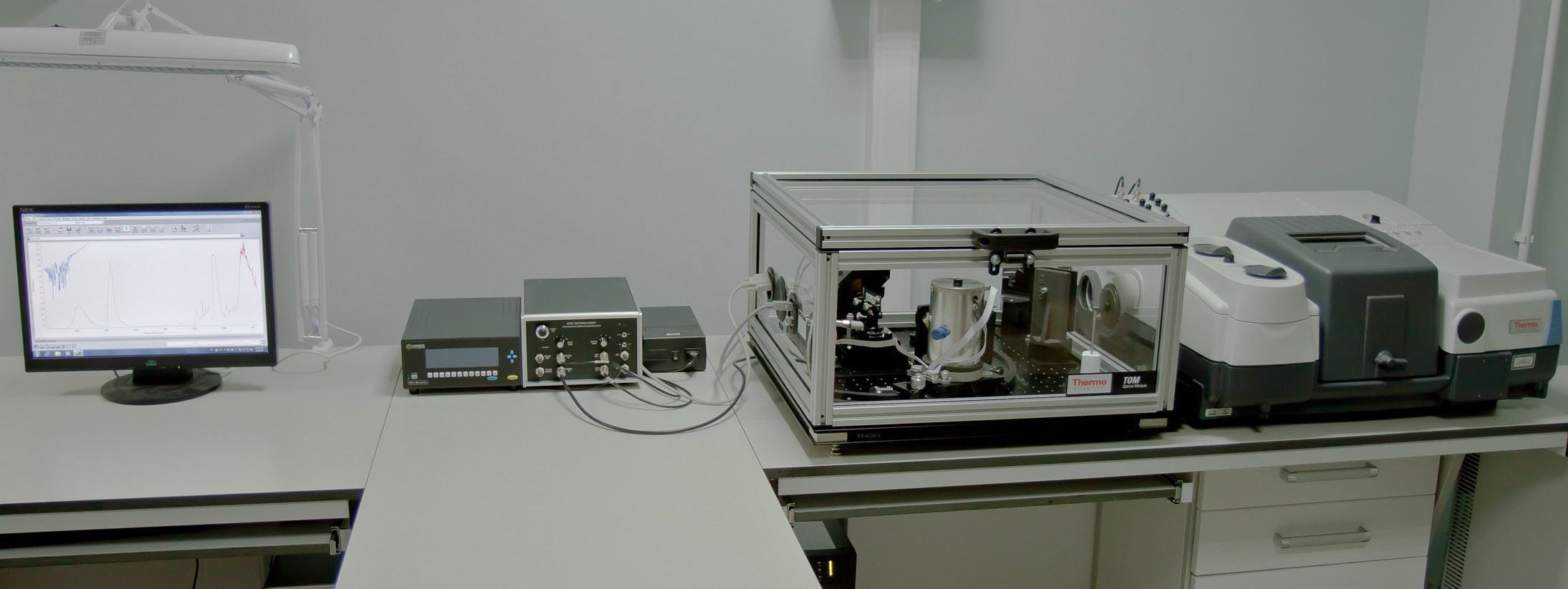
FTIR spectroscopy is used to determine the content of various organic and inorganic substances and their compounds in solid, liquid and gaseous samples (food, soil, metals and their alloys, polymers, etc.) on the absorption spectra.
The principle of the device is based on the fact that the motion of one of the mirrors of the interferometer is a change of the path difference between the interfering beams. The recorded light flux at the interferometer output (interferogram) is the Fourier transform of the detected optical spectrum. Self-spectrum (in wavenumber scale) obtained after performing an inverse Fourier transform.
Fourier spectrometer is additionally equipped with a broad spectrum of class libraries of compounds, which allows for identification of the samples.
Main characteristics:
- The spectral range 11000 – 350 cm-1
- Resolution 0.1 cm-1
- Wavelength Reproducibility, cm-1, 0.01
- Speed scanning at a resolution of 16 cm-1, 90 scan/s
- Type of spectrometer - a Michelson interferometer, 90 degrees
- The number of mirrors in an interferometer 2pc
- Adaptive dynamic automatic tuning mode of the interferometer for SST (Step scanning) and TRS (time-resolved measurement)
- Two sources operating without water cooling system: for near / mid-infrared (wavelength range 20 000 - 2000 cm-1) and for the middle / far-infrared (wavelength range 9600 - 20 cm-1), including a system to automatically switch detectors team of software
- Thermoelectric detector deuterated triglycine (DTGS), the range of 12000 - 350 cm-1
- Detector for far IR deuterated triglycine with plastic window (DTGS / PE), the range of 700 - 50 cm-1
- Cooled detector, crystal based mercury-cadmium-tellurium range 11700 - 600 cm-1, window KRS-5
- - Signal to noise ratio (peak to peak) for 1 minute scan with a resolution of 4 cm-1 50 000:1
- Signal to noise (rms) for 1 minute scan
with a resolution 4 with cm-1 200 000:1
- The piezoelectric modulator to perform phase modulation offset range for phase modulation, λ He-Ne 0.5 – 4.5
- Cooled detector to TRS (time-resolved spectroscopy), is based on the crystal mercury-cadmium-tellurium, with built-in preamp outputs have DC and AC output voltage range of 10 V, the detector time constant of 10 ns
- The operating frequency of the detector for the TRS, 50 MHz
- Fast analog-to-digital converter for TRS
- Limit frequency converter for TRS, 100 MHz
- An internal buffer converter for TRS, 8 Mb
- Bit converter for TRS 14 bit
- Optical filters TRS, 1975 cm-1 and 3950 cm-1
Additional accessories and attachments:
1. The Tabletop Optical Module (TOM) for Nicolet FT-IR spectrometers is a versatile external experiment module for polarization modulation (PM) experiments with maximum flexibility.
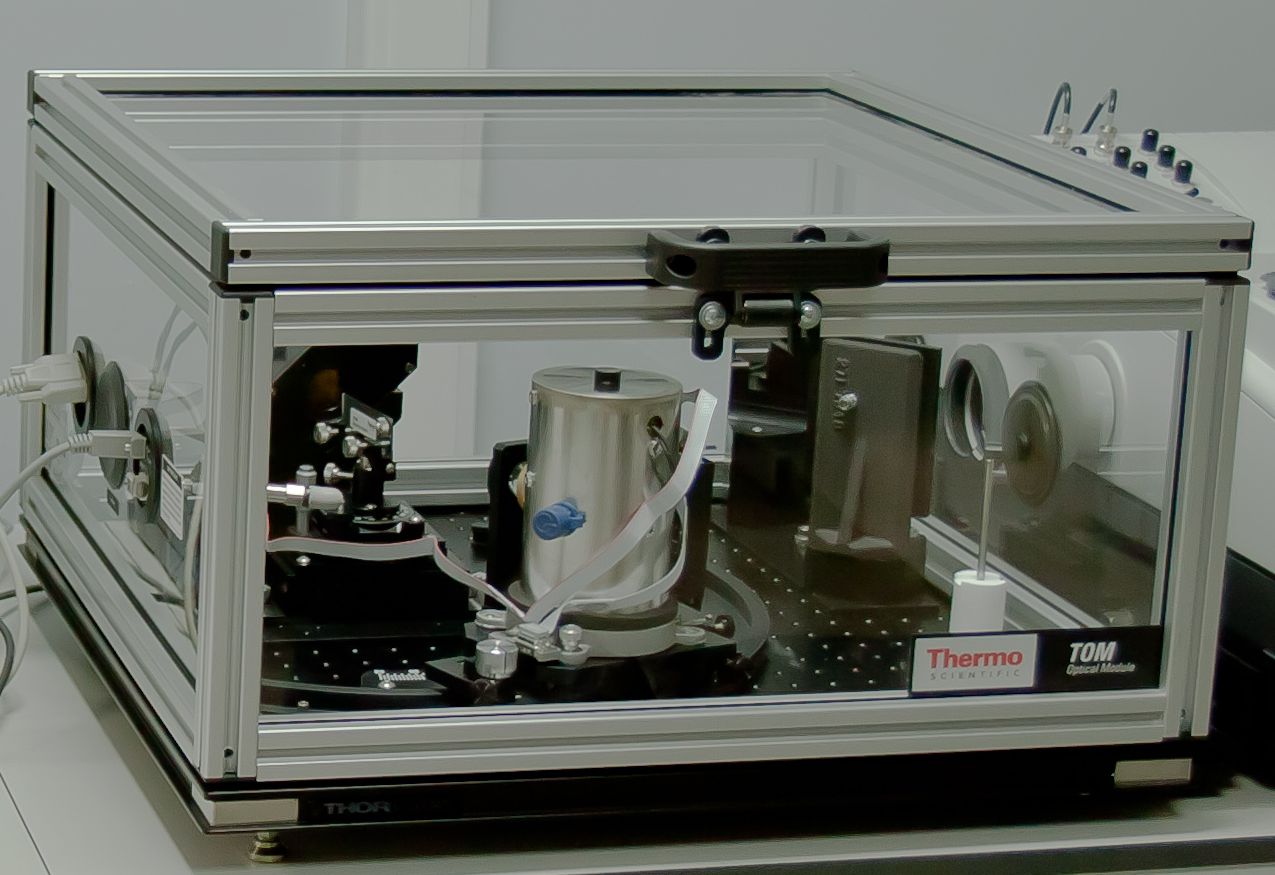
The Tabletop Optical Module (TOM) effectively meets the needs of all PM experiments when combined with a research-grade Nicolet FT-IR spectrometer that is equipped with Synchronous Sampling Techniques (SST) and step-scan SMM technology. The TOM experiments than can be performed with the TOM configuration include:
- Infrared reflection absorption spectroscopy (IRRAS)
- Vibrational linear dichroism (VLD)
- Dynamic infrared linear dichroism (DIRLD)
Main characteristics:
- The frequency of the modulator, 50 kHz
- Dem, 100 kHz
- Aperture polarizer for TOM, 30 mm
- Sample Holder for TOM, for transmission measurements
- Cooled detector for TOM, crystal based mercury-cadmium-tellurium, with a window of barium fluoride, range 11700 - 600 cm-1
- The range of angles of reflection measurements, 33 - 89 degrees.
Information on the manufacturer's website
2. Smart iTR
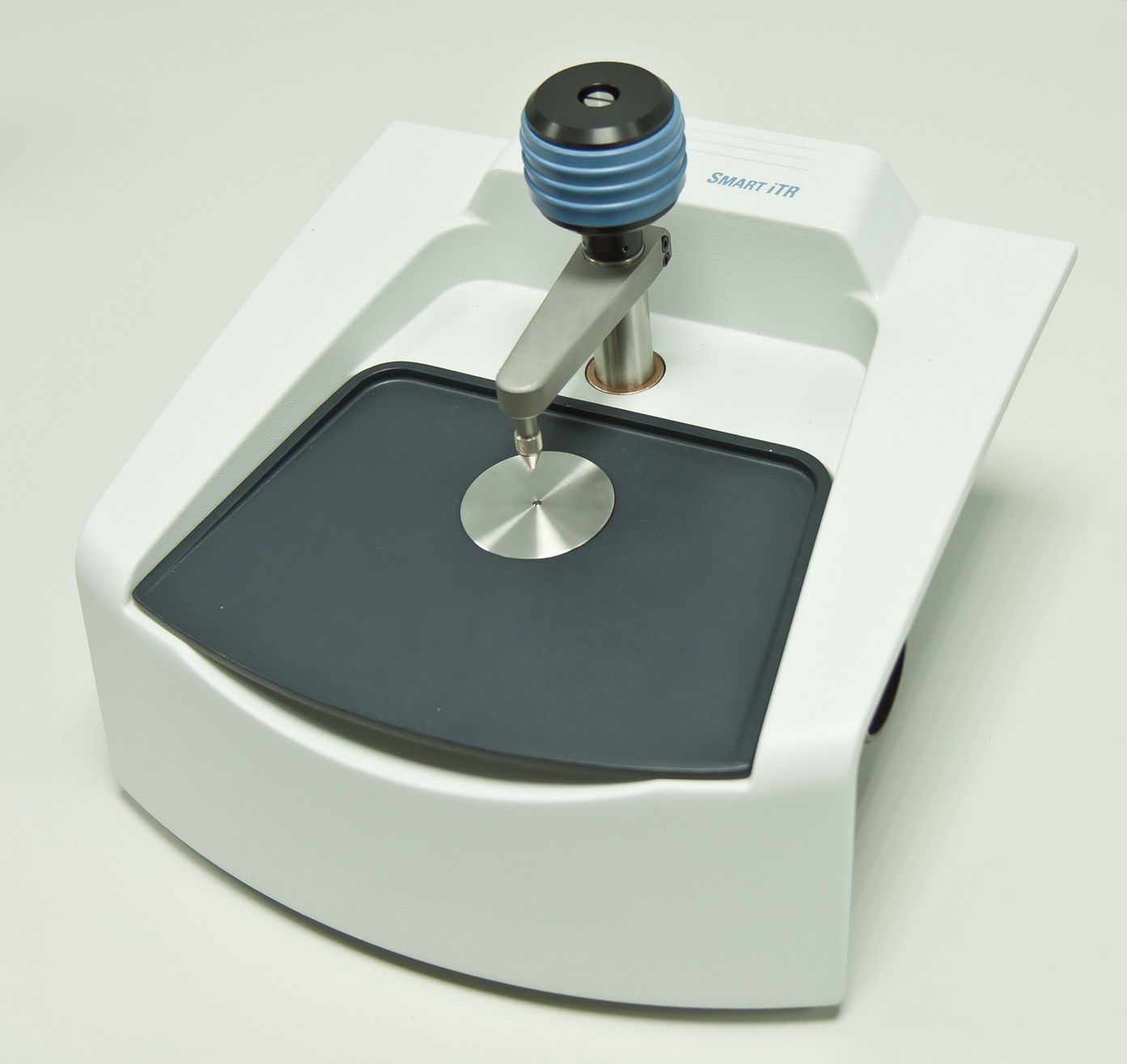
The Thermo Scientific Smart iTR™ is an ultra-high-performance, versatile Attenuated Total Reflectance (ATR) sampling accessory. Primarily designed for use with a single bounce diamond crystal, the Smart iTR also offers other options for full configurability. Each of the ATR crystals is designed for maximum infrared throughput and spectroscopic performance. ATR is the technique of choice for infrared and the Smart iTR is the accessory of choice for Thermo Scientific spectrometers. It provides exceptional sensitivity and IR throughput. ATR crystals come in a variety of configurations suitable for every need. Solid materials can be pressed onto the ATR crystal using a high pressure tower to provide consistent results. Single bounce ATR works for many strongly absorbing materials like polymers, chemicals, etc.
Information on the manufacturer's website
3. Smart Diffuse Reflectance.
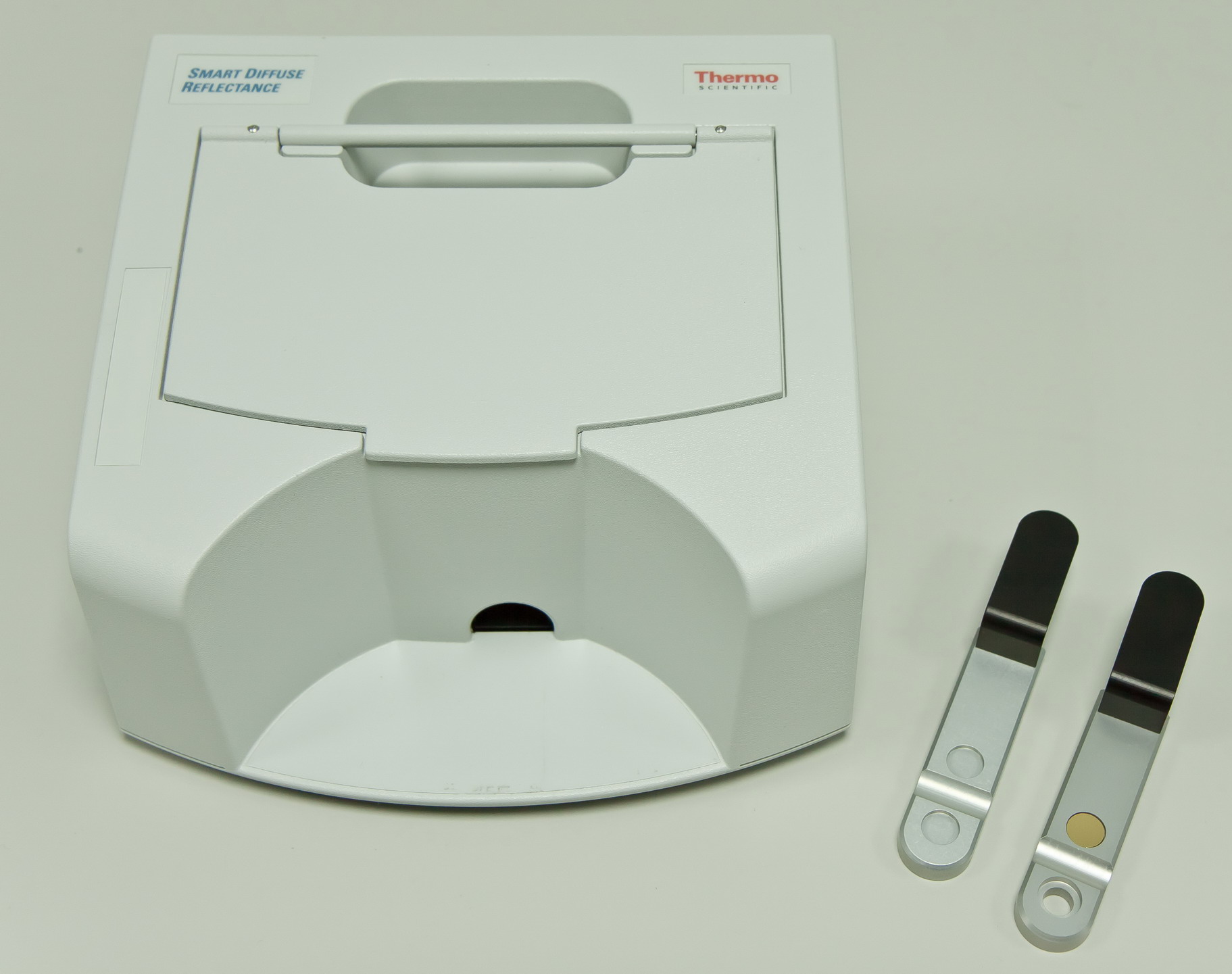
The Thermo Scientific Smart Diffuse Reflectance accessory is highly effective at maximizing diffusely scattered radiation while minimizing specular reflected radiation which is a source of spectral interference. Samples can be analyzed as is, with a slight amount of grinding or by grinding and mixing with potassium bromide (KBr). A wide variety of samples can be analyzed non-destructively.
Example Applications:
- Hard and soft powders;
- Organic and inorganic materials;
- Paint chips;
- Inflexible sample that can be abraded with silicon carbide paper.
Information on the manufacturer's website
4. Thermoelectric detector deuterated triglycine (DTGS) range 12000 - 350 cm-1
5. Detector for far IR deuterated triglycine with plastic window (DTGS / PE), the range of 700 - 50 cm-1
6. Cooled detector , crystal based on mercury-cadmium-tellurium range 11700 - 600 cm-1 , window KRS-5
7. Demountable liquid cell with a set of Teflon spacers, 0.015, 0.02, 0.05, 0.1, 0.2, 0.5 mm with a set of windows of potassium bromide.
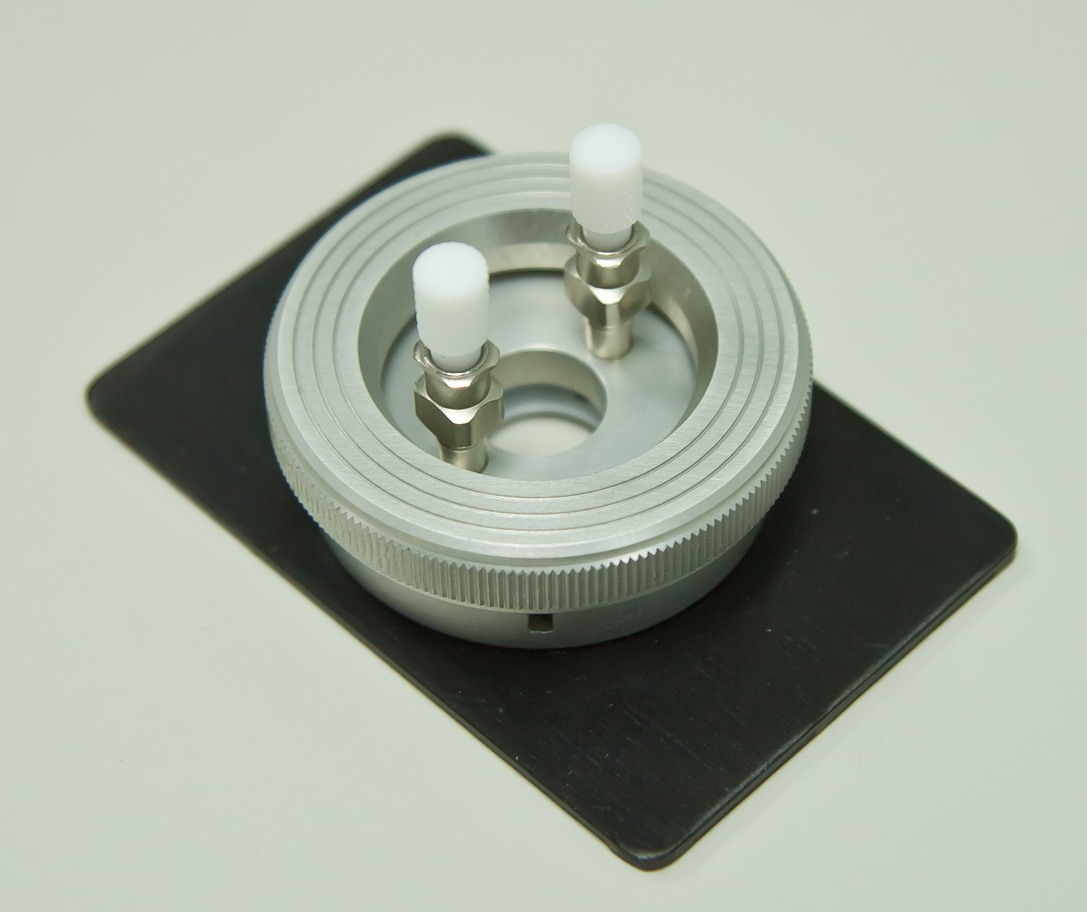
8. Cuvette gas, 100 mm with a set of windows of barium fluoride.
9. A set of interchangeable holders.
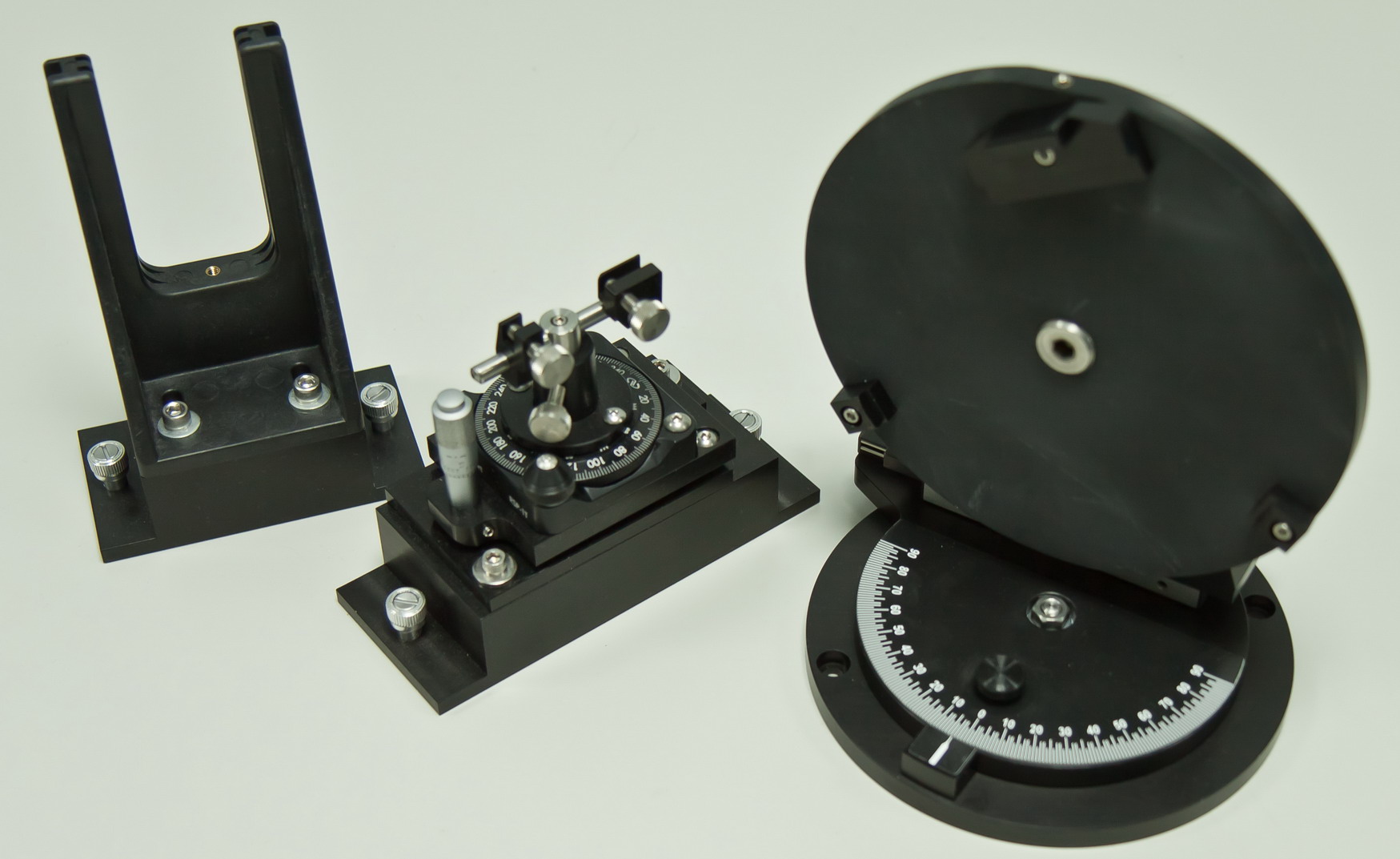
Posted in Научное оборудование
Microscopes
1. Research system microscope BX-51 (Olympus)
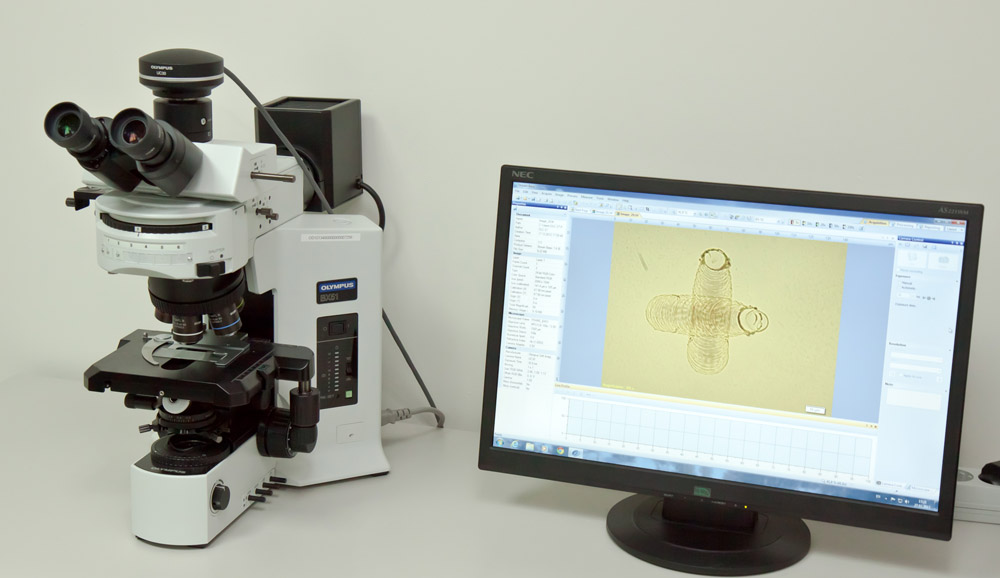
Main characteristics:
Tripod microscope for measurements in transmitted and reflected light.
Transformer to provide electrical power backlight power 100W.
Focusing stroke of 25 mm.
Maximum load on table 500 g.
Color digital CCD camera with a matrix size of 3.2 megapixels.
Information on the manufacturer's website
2. Micro interferometer MII-4М (LOMO)
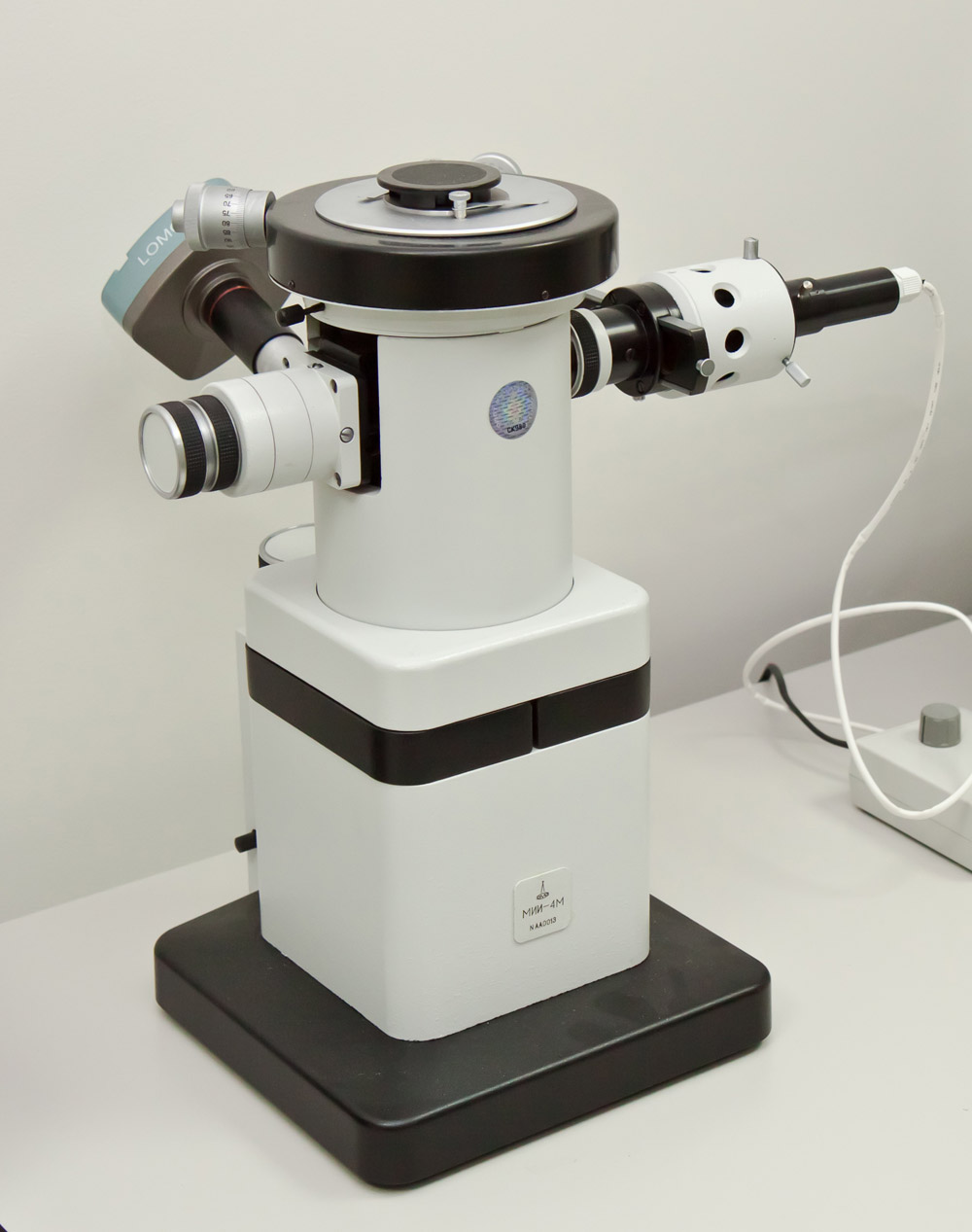
Main characteristics:
The ability to measure the height of the step parameters, film thickness and surface roughness in the range from 0.1 microns to 0.8 microns.
The increase in sightings 500-fold.
Linear field of view in the object space of 0.3 mm.
The measurement of roughness parameters using an ocular micrometer screw.
The measurement of roughness parameters with a photoelectric ocular micrometer.
Information on the manufacturer's website
3. Polarizing microscope POLAM R-312 (LOMO)
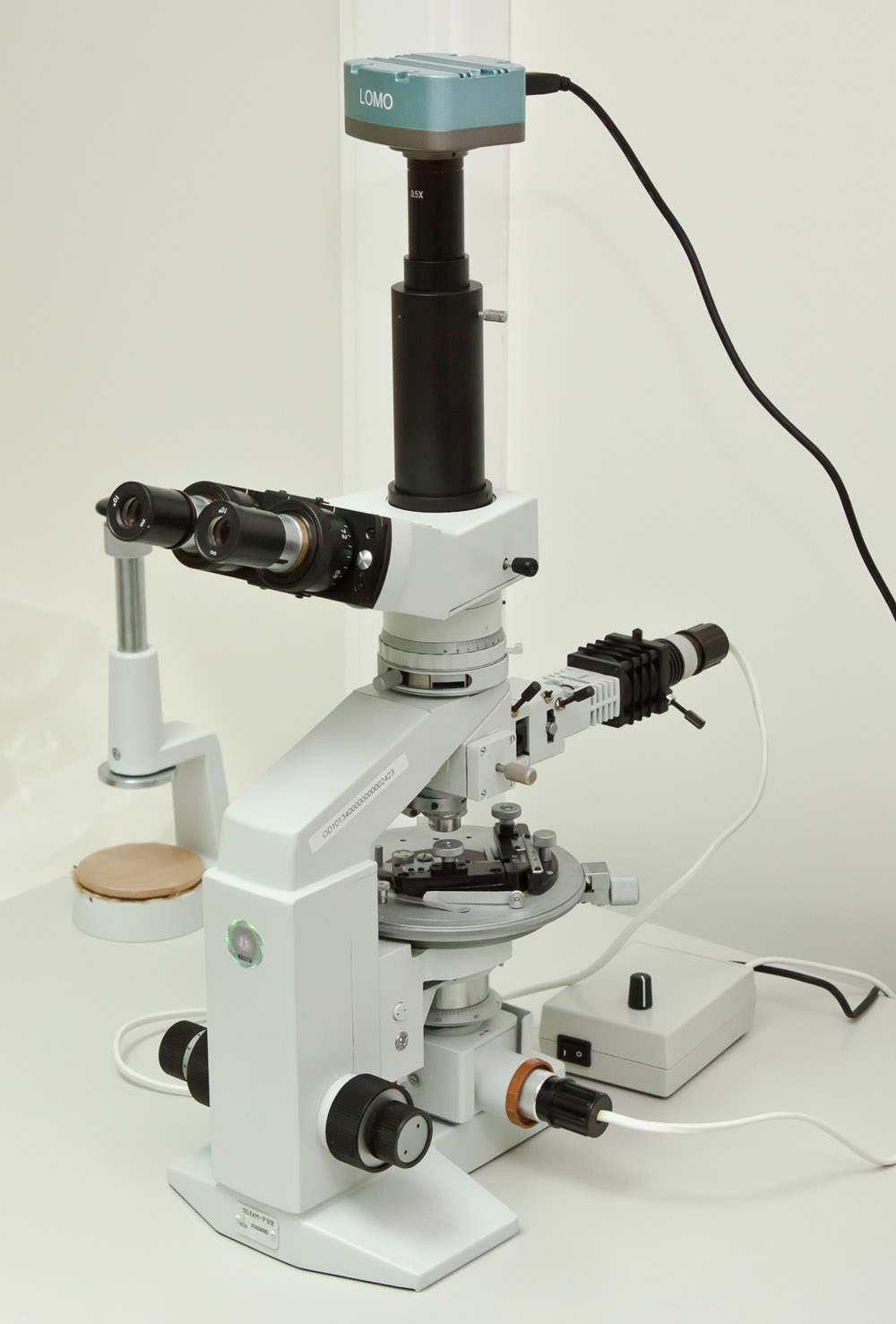
Main characteristics:
Condenser aperture of the transmitted light is not less than 0.3.
Possible to study objects in the polarization light.
Color digital CCD camera with a matrix size of 3 megapixels.
Information on the manufacturer's website
Posted in Научное оборудование
Express-Raman spectrometer SENTERRA (Bruker)
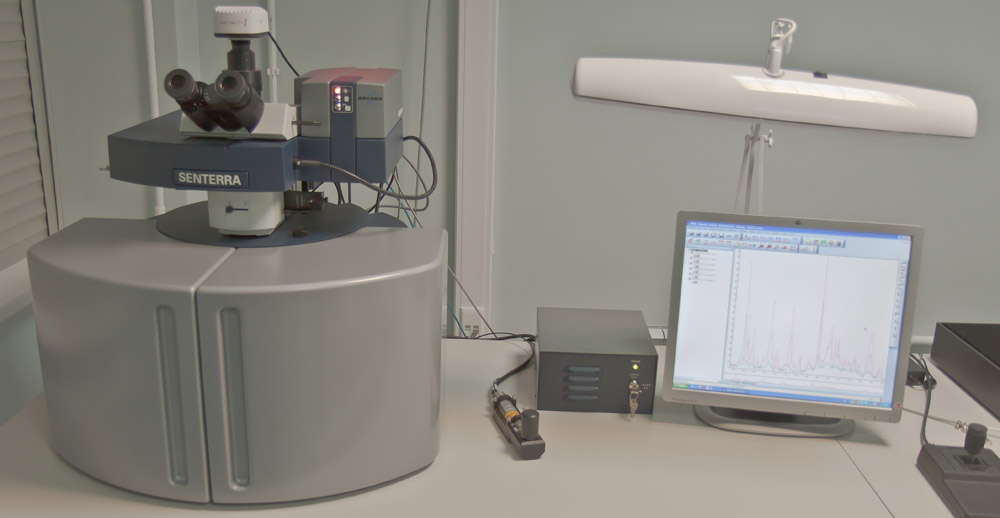
Presented spectrometer allows to conduct express and routine measurement of Raman spectra. The complex has the ability to measure liquids and solid samples: glassy, crystalline, organic and inorganic substances in the form of powders, thin films, and can work with microquantities of the substances. The complex has a system of optical imaging of the samples - Olympus. The spectrometer is equipped with three lasers with wavelengths of 488, 532, 785 nm, and fiber-optic sensor for registering the spectra of samples in an external sample compartment.
Main features:
- Spectrometer is located on a platform of the confocal optical microscope and it has a class I protection from laser radiation.
- Spectral range of recording the Raman spectra of 80-4500 cm-1.
- Spectral resolution: better than 3 cm-1.
- Calibration wavelength: continuous, throughout the process of registration of the spectrum.
- Wavelength of the excitation laser (in parentheses the maximum power is shown): 532nm (20mW), 785nm (100 mW), 488 nm (40 mW).
- ДDetection: High-sensitive CCD detector with a Peltier-cooling to -70оС.
- 2 diffraction gratings - 400 grooves/mm and 1200 grooves/mm.
- Polarizer for measurements in polarized light.
- Fiber-optic sensor for recording the spectra of samples in an external sample compartment.
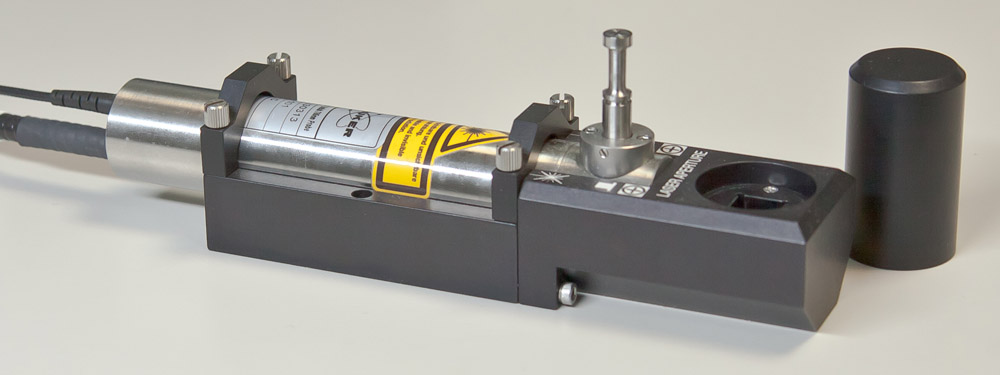
Characteristics of the confocal microscope with the visualization device:
- Spatial resolution: 1 mm.
- The confocal optics with hybrid iris controled by computer.
- Aperture: combined slotted aperture for high luminosity and round aperture for confocal measurements.
- Confocal a resolution 2 microns.
- Color CCD camera to visualize the viewpoint, with a resolution 1.3 megapixel.
- Trinocular head for optical lenses with different degrees:
- 20x (working distance: 1.3mm)
- 50x (working distance: 0.38mm)
- 4x, 10x, 50x (long-focus)
- 100x (operating distance: 0.9 mm)
- Stage: an automated, controled with joystick and software, movement range: 75mm x 50mm, movement accuracy: 0.1mkm.
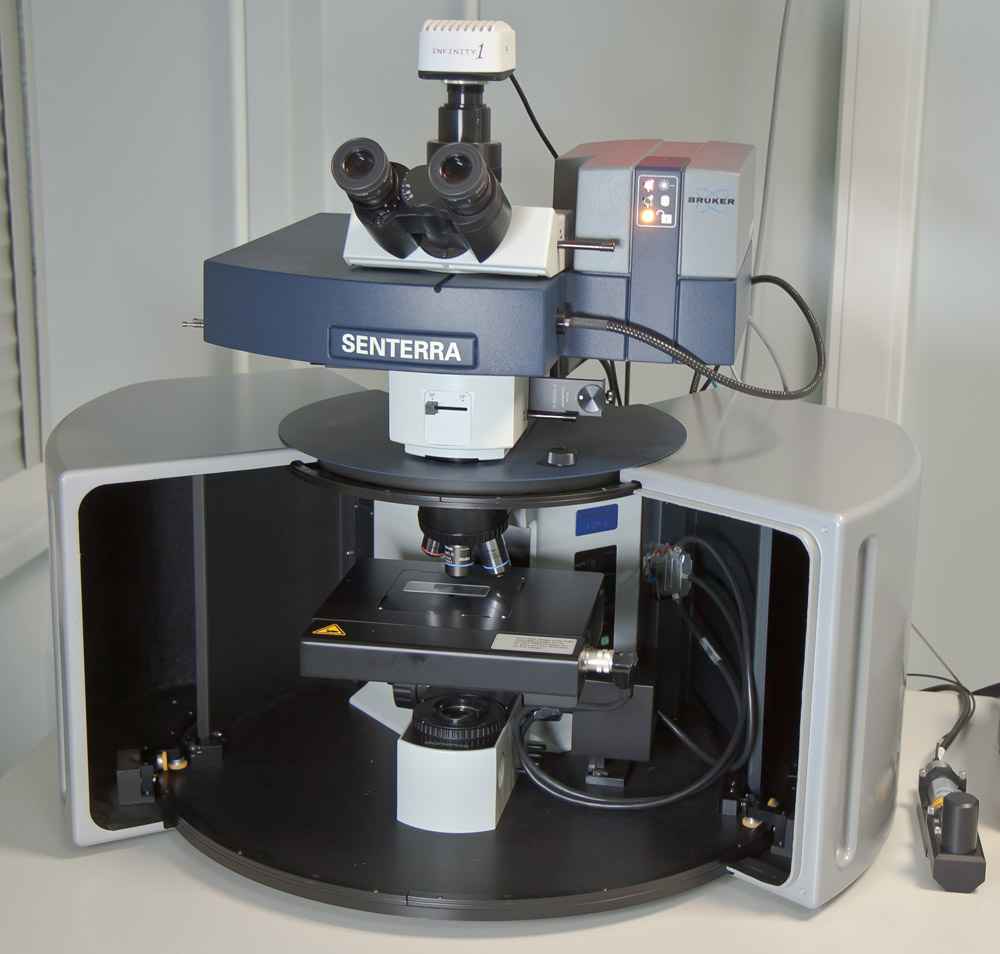
Software features:
The software kit for the spectrometer control allows to diagnosethe operating capacity of the optical system, the registration of spectra, measured data processing with special software packages:
- Identification with the optimization function of the spectrum.
- Implementation of univariate and multivariate analyzes.
- Conducting the routine analysis.
- Three-dimensional visualization of spectral data.
- Identification of the substance using the library search, the ability to build their own spectral libraries.
- The function of the spectrum intensity correction.
- Automatic fluorescence rejection of the laser with a wavelength of 785 nm.
- Library of the Raman scattering spectra.
Fields of application:
Typical applications of Raman spectroscopy in materials science and nanotechnology:
- Materials for the study of any type of inorganic and organic materials, including semiconductor elements;
- In gemology, mineralogy for the study of gems, minerals;
- In organic chemistry for the study of reaction mechanisms of synthesis and characterization of the products;
- The development and control of various production processes;
- In criminology, Raman spectroscopy can be used to identify:
- Paints, inks (car accident, identification of the figure)
- Polymer films, different fibers, shot, glasses
- Explosives, drugs, toxic substances
- The composition of explosive mixtures of powders
- In the pharmaceutical industry in the development and production control tablet forms of drugs and creams;
- Determination of lattice defects;
- The study of corrosion processes
Information on the manfacturer’s website
Posted in Научное оборудование
Research-grade Raman spectrometer T64000 (Horiba)
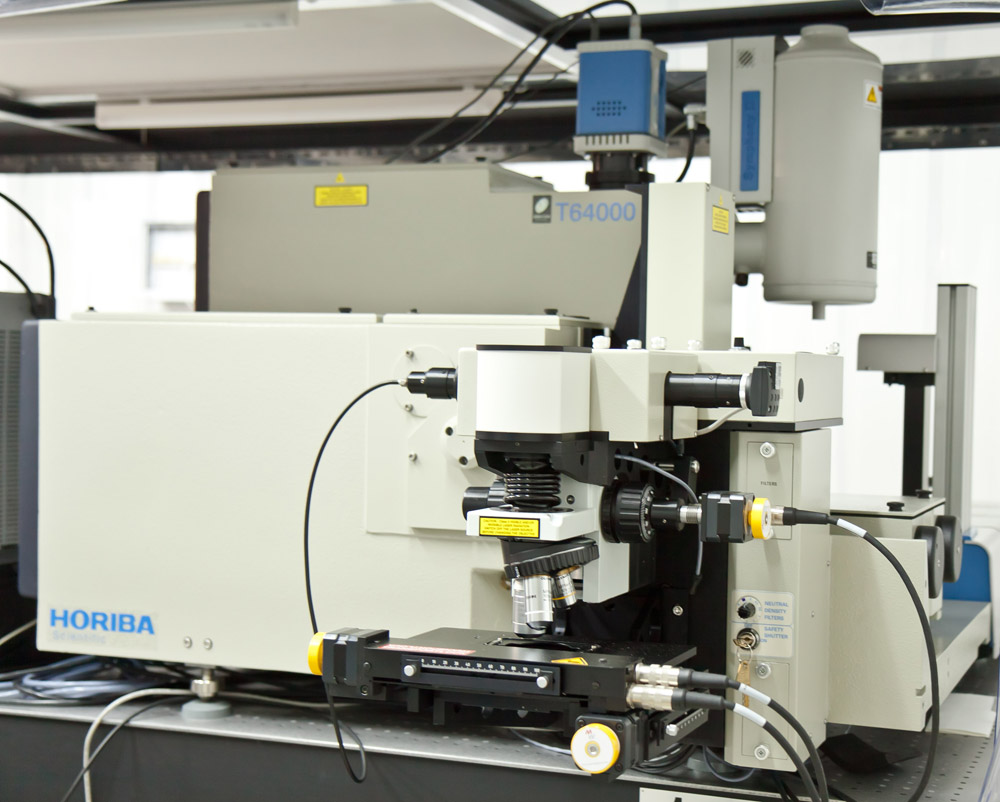
СThe T64000 system is designed to provide a versatile platform for Raman analysis. It has an integrated triple spectrometer design for unprecedented optical stability. The optical coupling is efficient and throughput is limited only by theoretical considerations.
High stray light rejection
Holographic notch filter technology provides a very good solution to laser rejection for visible wavelengths. However, there are acknowledged limitations to the use of these filters for work close in to the laser line. Even with specially developed low frequency accessories with many difficult samples it is still often impossible to obtain reliable data at 10 , 20 or 30 cm-1. In using the double subtractive configuration of the T64000, it is possible to obtain spectral information very close in to the laser line. The subtractive mode is ideal for studying such detail as LA modes in polymer systems and crystal lattice modes.
Ultra high resolution
With the use of the ultra-high resolution triple additive configuration of the T64000 triple system, it is possible to very accurately study the position of Raman bands. This is of particular importance for the measurements of stress in semiconductor materials such as GaN, SiC and diamond where stress induced shifts in the order of 0.1 cm-1 are often studied. The high resolution also offers the level of accuracy required for the authentication and certification of materials for Raman standards.
T64000 spectrometer is designed to register Raman spectra of solid and liquid samples with high optical resolution and the ability to obtain spectral information at low frequencies (up to 2 cm-1 from the line of the laser excitation).
List of applications to which T64000 can be applied includes thin film, solid state devices, biological chemistry, resonance Raman and photoluminescence.
Main features:
- The device contains a triple monochromator, adjusted for chromatic aberrations, with a focal length of 640mm
- The device operates in the following modes: the subtracting dispersion, the dispersion of addition and in single monochromator dispersion.
- The kit includes a set of holographic diffraction gratings 600 grooves/mm, 1800 grooves/mm and 2,400 grooves/mm
- The dispersion at a wavelength of 600 nm with the lattice 1800 grooves/mm in subtraction mode 0.64 nm / mm, in addition mode 0.21 nm / mm
- Spectral resolution at the wavelength of 600 nm with the lattice 1800 pieces / mm in the addition of 0.0055 nm (0.15 cm-1)
The confocal microscope conjugated to a spectrometer:
- Coverage: the visible and near-infrared light
- Spatial resolution 1 micron
- The limit of confocality 2 microns
- The kit includes objectives: 10x (0.25 mm aperture), 50x (0.5 mm aperture), 50x (0.75 mm aperture), 100x (aperture 0.9 mm) for the visible range; 40x (aperture 0 5 mm) for the UV range; 100x (aperture 0.9 mm) for the IR range

Excitation source:
- Diode laser with a wavelength 785 nm, 100 mW power, the width of the exciting line of 50 MHz
Detection system:
Multichannel CCD detector with Peltier elements cooling (-70°С):
- The detector is optimal for a range of 200 to 1050 nm
- Resolution 1024x256 pixels, a pixel size 26x26 mm, chip size 26,6 x6, 7 mm
- Quantum efficiency 30% in the spectral range from 500 nm to 800 nm
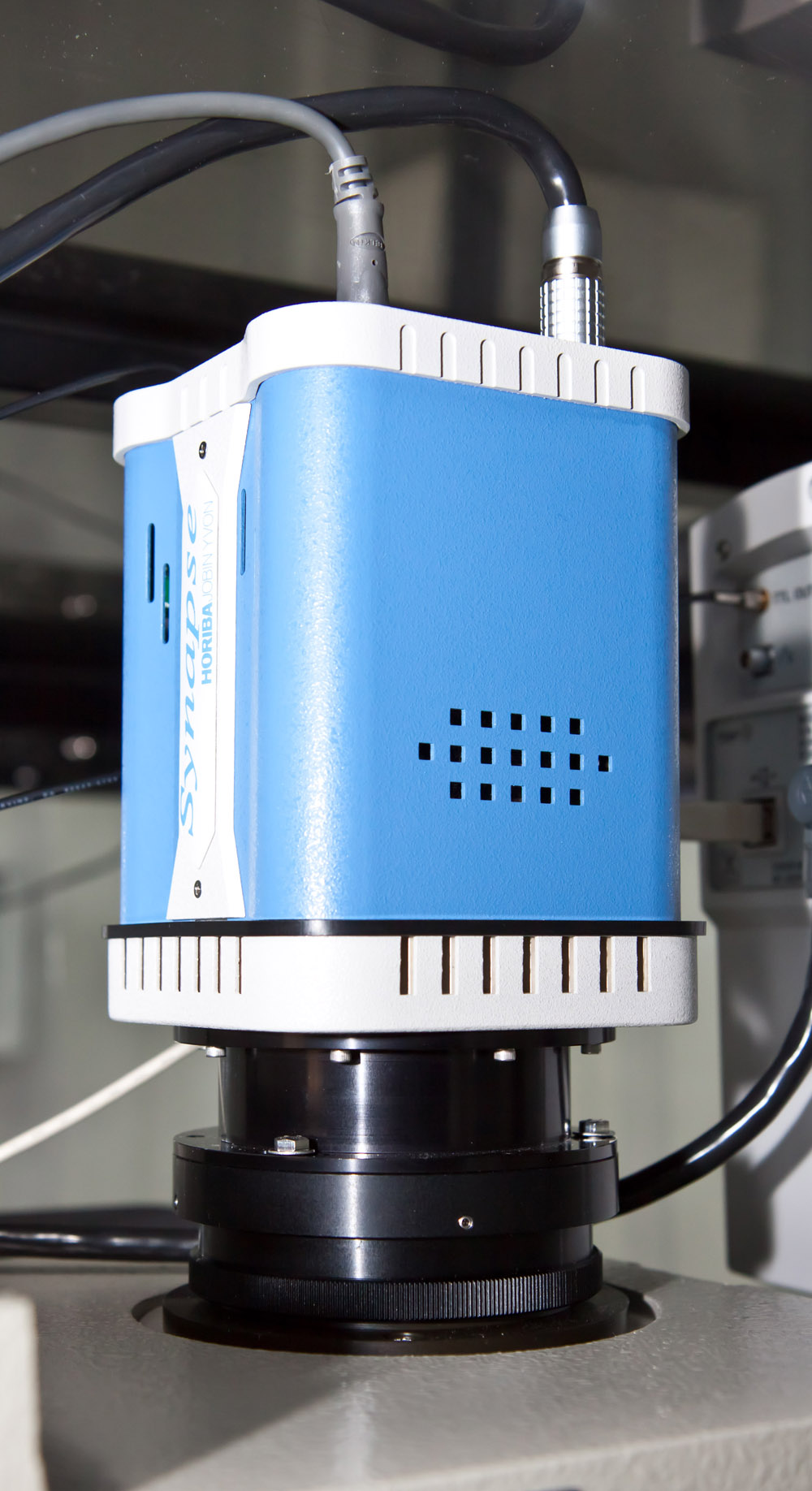
Linear detector cooled by liquid nitrogen:
- The detector photocathode is InGaAs, optimal spectral range from 800 nm to 1550 nm
- Resolution 1024 pixels, pixel size 50x50 mm, 25.6 mm work region
- Quantum efficiency 80% in the spectral range from 1000 nm to 1500 nm
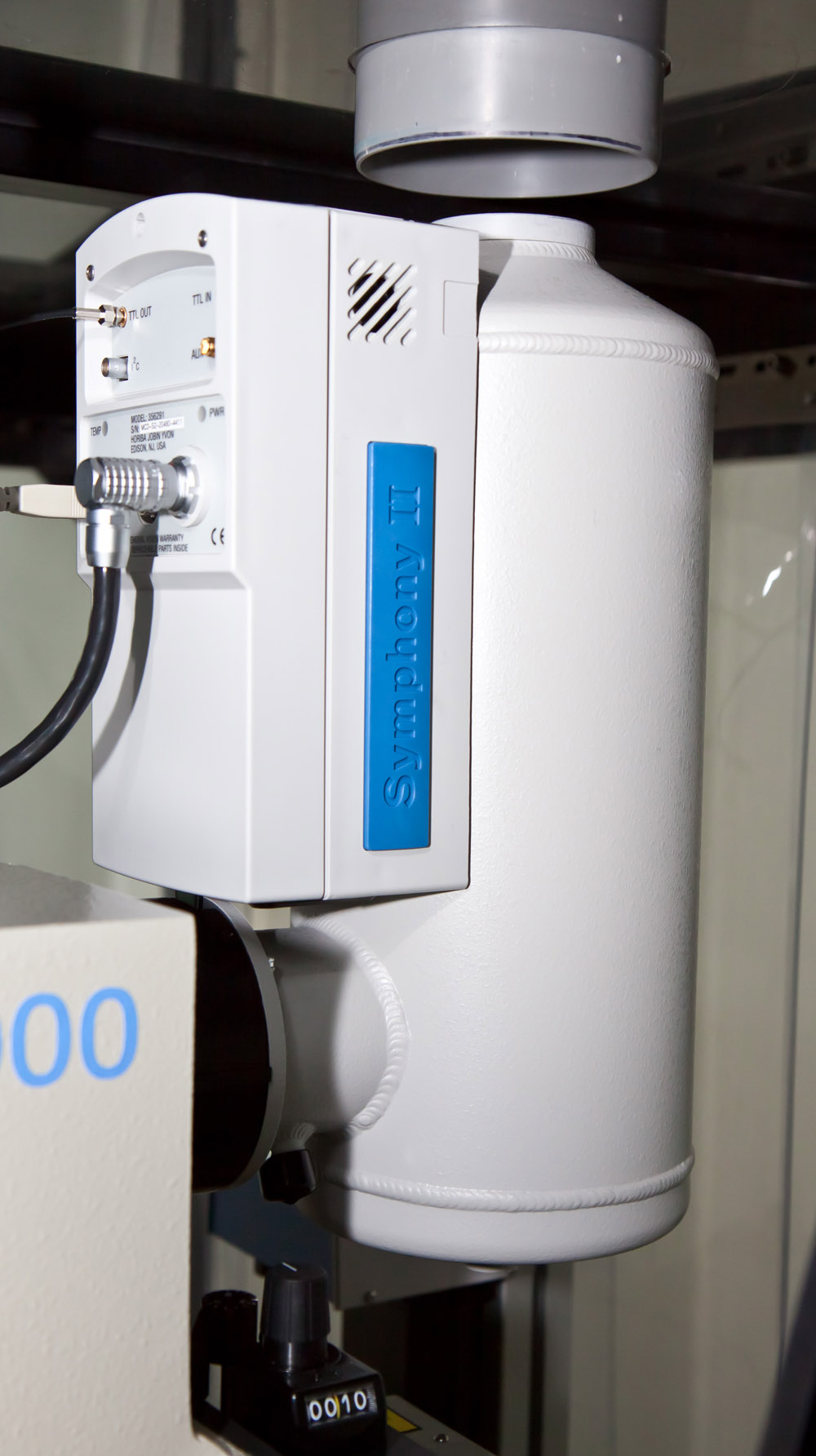
Information on the manufacturer's website







 English (UK)
English (UK)  Русский (РФ)
Русский (РФ) 













